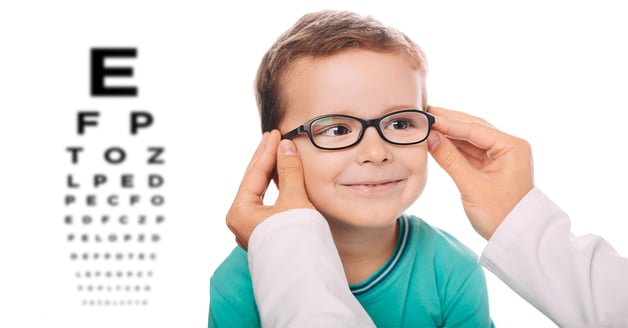
Looking ahead to the last few months of 2019 and on into 2020, there are a number of exciting trends impacting vision technology. Consumers can expect to see these trends popping up in the exam room, online, and increasingly throughout a normal day of work or play.
So, what’s on the horizon in vision care technology?
Smart frames are coming back
 Google Glass made huge waves when it first appeared in 2014, but went out with a fizzle the next year. In many ways it was ahead of its time, and targeting consumers with a funny-looking, bulky pair of frames that had few practical purposes and cost $1500 turned out to be a misstep for the search giant.
Google Glass made huge waves when it first appeared in 2014, but went out with a fizzle the next year. In many ways it was ahead of its time, and targeting consumers with a funny-looking, bulky pair of frames that had few practical purposes and cost $1500 turned out to be a misstep for the search giant.
But, the tech itself was sound and Google never stopped working on it. This year, Google Glass 2 was released with a business focus, and it’s taking off far more successfully.
Of course, this is just the best known of a relatively new and expanding type of electronic wearable: Smartglasses. Much like smartwatches (and phones, for that matter), smartglasses offer some convenient and fun benefits such as activity tracking, call and text notifications, appointment reminders and more. And, since glasses wearers always have their glasses on, they’re more convenient than some other options for those purposes.
But, smartglasses have a powerful superpower that’s really driving the trend today: augmented reality (AR). AR combines optical technology, eye-tracking, and ultra-fast computer processing to overlay digital images over the real world. It can be used, for instance, to view digital building plans overlaid over the actual construction site so workers can inspect measurements and placement. In the near future, as the technology continues to drop in price and smartglasses become more popular and widespread, it can easily be applied to enhancing the retail shopping experience, adding a new dimension to entertainment, and even providing digital context to everyday sights.
Expect to see smartglasses hit the mainstream in the next year.
Blue light protection - an old idea that’s finally hitting the mainstream
 Anytime you look at an unfiltered digital screen, a portion of the light your eyes are absorbing is in the blue wavelength. Of course, blue light — the strongest portion of the visible spectrum — is all around us all the time. However, with most of us spending more and more of our waking hours staring at a screen these days, the strong blue light coming from screens can potentially harm your vision.
Anytime you look at an unfiltered digital screen, a portion of the light your eyes are absorbing is in the blue wavelength. Of course, blue light — the strongest portion of the visible spectrum — is all around us all the time. However, with most of us spending more and more of our waking hours staring at a screen these days, the strong blue light coming from screens can potentially harm your vision.
As reported at All About Vision, there are a number of reasons why blue light can be harmful, including “digital eyestrain,” loss of sleep and sleep quality, and even a condition similar to macular degeneration.
Doctors have known this for years, and most everyone has heard it at some point. Video Display Terminal (VDT) glasses and “blue blocker” lenses have been around just as long. But it’s only recently that this type of eyewear has truly hit the mainstream at popular retailers both online and off.
By applying special coatings and tints to plano or prescription lenses, eyeglass manufacturers can help relieve the issues that come from excess blue light. And, since it’s finally become as popular an idea as it deserves, these specialty glasses are available in thousands of attractive frame styles. You can even discuss with your eye doctor getting a pair made with an intermediate prescription, optimized for the average distance your favorite screen is from your eyes while you work.
Innovative materials driving trends in glasses and contacts
 A newly released study of the global vision care market reported the following:
A newly released study of the global vision care market reported the following:
“The global vision care market is expected to reach around $74 billion, growing at a CAGR of more than 3% during the forecast period.”
The report went on to note that one of the driving forces of that growth is the use of innovative new materials that are making eyeglasses and contact lenses less expensive, more comfortable, and more effective, all of which makes them more popular.
Some examples include the use of silicone hydrogel for soft contact lenses, which offers better oxygen breathability than conventional plastic, and high-index plastic eyeglass lenses that offer high refractive correction in a physically slim lens design. Again, these aren’t necessarily brand new technologies, but they’re becoming more affordable and more widely available, so they’re trending like never before.
Ever-changing eyewear fashion impacts trends too
 Eyewear fashion trends are always going to have an impact on vision care too. And that makes sense: we all want to look our best, and sometimes that means changing things up. In frames, retro styles from the 60s, 70s, and 80s are coming back in a big way. Some examples of current and coming trends include:
Eyewear fashion trends are always going to have an impact on vision care too. And that makes sense: we all want to look our best, and sometimes that means changing things up. In frames, retro styles from the 60s, 70s, and 80s are coming back in a big way. Some examples of current and coming trends include:
- 60’s: Cat’s-eye and Jackie Onassis-style round, white frames
- 70’s: Huge, face-hiding frames and with earth tone tints
- 80’s: Aviator-style sunglasses (no mirrored lenses though!)
You can bet your bell bottoms that all of these frames are made of tougher, lighter, more wear- and chemical-resistant materials than their original counterparts. Eyeglass manufacturers are focusing more than ever before on building frames that last.
Other trends to check out
Of course, there’s a lot more going on in vision care technology these days than we could possibly cover here. Here are some other interesting tech trends to check out:
- An eye exam you give yourself
- A device that tracks your eye movements to identify health problems
- A number of advancements in the treatment of low vision
- And, if you’re ready for it, a 3D-printed cornea
Whether you end up exploring the newest trends or you’re satisfied with the old standbys, keeping up with your vision care is a worthwhile priority. If you ever find cost getting in the way of doing so, Wellness Complete may be the best trend you could learn about.

